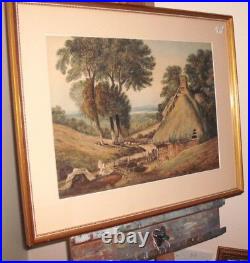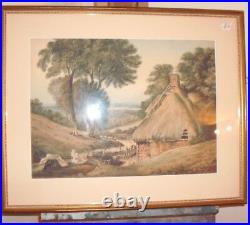Antique Victorian Watercolour Painting Landscape Framed English Unsigned c 1880










Antique Victorian Watercolour Painting Of a. Antique Victorian watercolour painting of the English country side, depicting a dilapidated shepherds cottage (run down) with the thatch coming off, shepherds and sheep in the background. It has very slight foxing and a minor sun bleaching considering that it is a Victorian watercolour painting, at least 120 - 150 years old; it remains in a very good condition colours being quite bright and sharp.
On the back has a label from a previous dealer in Scotland, Colin Murdoch (B1919- D2014) the shop ran from 1975 to 1995. Size frame 25"x20.5" high.
Slight foxing and sun bleaching. Frame is a faux Gilt effect. Watercolour paintings are prized for their ethereal beauty and their ability to evoke a range of emotions.
The soft, translucent nature of watercolour paints allows artists to create subtle gradients and depth, often resulting in paintings that feel alive, light, and luminous. This unique quality makes watercolours perfect for depicting landscapes, florals, portraits, and still lifes in a way that captures a fleeting moment or a sense of peace. Additionally, watercolours often have a sense of spontaneity and fluidity that other mediums like oil or acrylic paint can lack.
Many buyers are drawn to the unpredictable nature of watercolour, where the water interacts with pigments in unexpected ways. This randomness can lead to surprising, sometimes abstract, results that resonate with collectors and enthusiasts alike. Watercolour paintings are also more accessible than other types of art.Generally, they are smaller in size, lighter in weight, and often less expensive to frame and display compared to oil or acrylic works. As a result, they tend to appeal to a broader range of buyers, from new collectors looking to start their art collection to those who simply want an affordable piece of art to brighten up their homes. Can Watercolour Paintings Be an Investment? While watercolour paintings have long been considered a lesser medium compared to oil paintings in the eyes of some collectors, there is a growing recognition of their value as both beautiful works of art and potential investments.
Over the years, certain watercolour artists have gained significant recognition and, as a result, their works have appreciated in value. Investing in watercolour paintings can be a wise decision if one is knowledgeable about the market and aware of artists who are gaining prominence.A work by a renowned artist such as J. More contemporary artists who have cultivated a following for their watercolour techniques can also see their works increase in value over time, especially if their artistic reputation continues to grow. However, like any art form, the value of a watercolour painting depends on various factors, including the artist's reputation, rarity, condition, and historical importance. Who Is the Most Popular Watercolour Artist?
Throughout history, many notable artists have excelled in watercolour painting, but one of the most famous and influential is J. Turner is widely regarded as one of the greatest British painters, and his innovative use of watercolour in landscape painting revolutionized the medium. His works, such as The Blue Rigi and Snow Storm: Steam-Boat off a Harbour's Mouth, demonstrate his mastery of light, atmosphere, and fluidity, setting a benchmark for future watercolour artists.Sargent, in particular, was known for his fluid, expressive portraits painted in watercolour. Today, many artists, such as Robert Wade, and the watercolourist community on platforms like Instagram, are building strong followings for their distinctive approaches to the medium. While it's hard to pinpoint a single most popular watercolour artist today, figures like Turner remain highly influential in the watercolour world, and modern artists continue to develop unique styles that challenge conventions and keep the medium fresh and exciting. How Long Have People Been Painting? The use of water-based pigments for painting can be traced back to ancient times.
The earliest known watercolour paintings date back to the cave paintings of prehistoric people, where natural pigments were mixed with water to create artworks on stone surfaces. However, the watercolour painting as we recognize it today evolved significantly during the Renaissance. In the 15th and 16th centuries, it was used primarily by artists for sketches and studies, often as preparatory work for more significant pieces in oil or tempera.
It wasn't until the 18th century that watercolour began to emerge as a respected and standalone art form. Artists like Albrecht Dürer and Leonardo da Vinci experimented with watercolour in their studies of nature, but it was during the Romantic and Victorian periods that watercolour gained widespread popularity as an independent medium, particularly in Britain. By the 19th century, it was a recognized artistic discipline, and institutions like the Royal Watercolour Society were founded to promote the medium. Today, artists from all over the world continue to embrace watercolour for its versatility and timeless appeal.
Watercolour paintings have been appreciated for centuries, and their distinct beauty continues to captivate viewers today. Whether bought for their aesthetic value or considered as a potential investment, watercolour paintings offer something unique. The medium's ability to convey light, colour, and emotion in delicate yet powerful ways ensures its continued relevance in the art world. From historic masters like J. Turner to contemporary watercolourists, the art of watercolour painting continues to inspire, delight, and occasionally appreciate in value, making it a cherished part of art history and cultur.